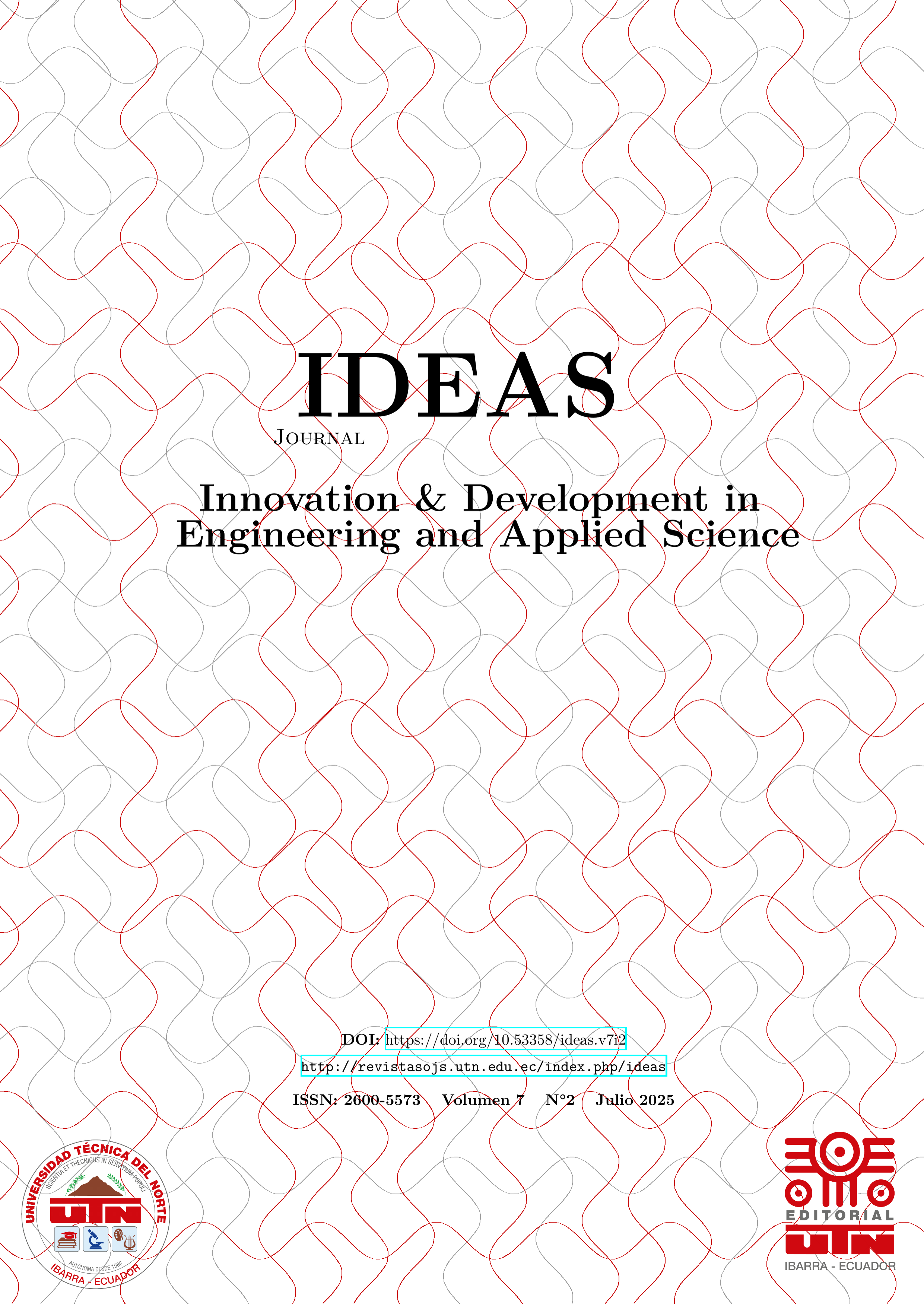Influencia de la Frecuencia y Tiempo de Inyección en el Funcionamiento de Inyectores CRDi
Contenido principal del artículo
Resumen
El artículo analiza la influencia de la frecuencia y el tiempo de inyección en el funcionamiento de inyectores electrónicos. En el proceso experimental, se controlaron dos variables independientes y tres dependientes, obteniendo la cantidad de entrega, retorno de combustible y presión en el riel mediante el uso de un equipo de simulación de pulsos de inyección. Se realizaron pruebas con diferentes combinaciones de tiempo y frecuencia. Los resultados mostraron que la frecuencia tiene una influencia significativa en la cantidad de inyección y retorno de combustible, siendo la variable más relevante. Se encontró que la entrega de combustible aumenta en función del tiempo y la frecuencia, siendo 1.5 ms el punto donde se obtuvo la mayor entrega al variar de 5 a 20 Hz. Además, la presión en el riel mostró una relación inversa con el tiempo de inyección y frecuencia, reduciéndose en un 17.5%, 11.1%, 11.4% y 11.7% en los valores de 5, 10, 15 y 20Hz, respectivamente. El análisis estadístico reveló que los modelos ajustados explican de manera efectiva la variabilidad de entrega de combustible y la presión del riel
Descargas
Detalles del artículo

Esta obra está bajo una licencia internacional Creative Commons Atribución-NoComercial-SinDerivadas 4.0.
Citas
M. M. Khan, A. Kumar Kadian, and R. P. Sharma, “Investigation of high fuel injection pressure variation on compression ignition engines powered by jatropha oil methyl ester-heptanol-diesel blends,” Alexandria Engineering Journal, vol. 65, pp. 675–688, 2023.
Q. Wang, F. Wei, P. Dong, G. Xiao, Z. Cui, J. Tian, X. Shi, and W. Long, “Visualization study on combustion characteristics of direct-injected hydrous methanol ignited by diesel in a constant volume combustion chamber,” Fuel, vol. 335, p. 127063, 2023.
P. Ni, H. Xu, Z. Zhang, and X. Zhang, “Effect of injector nozzle parameters on fuel consumption and soot emission of two-cylinder diesel engine for vehicle,” Case Studies in Thermal Engineering, vol. 34, p. 101981, 2022.
P. Wai, P. Kanokkhanarat, B. S. Oh, V. Wongpattharaworakul, N. Depaiwa, W. Po-Ngaen, N. Chollacoop, C. Srisurangkul, H. Kosaka, M. Yamakita, C. Charoenphonphanich, and P. Karin, “Experimental investigation of the influence of ethanol and biodiesel on common rail direct injection diesel engine’s combustion and emission characteristics,” Case Studies in Thermal Engineering, vol. 39, p. 102430, 2022.
L. Zhou, K. Yang, Z. Ping, T. Nie, X. Biao, and L. Huang, “Experimental study on the effect of post-injection parameters on performance of extra-high pressure common-rail diesel engine,” Energy Reports, vol. 8, pp. 152–160, 2022.
K. M. V. Ravi Teja, P. Issac Prasad, K. Vijaya Kumar Reddy, N. R. Banapurmath, M. E. M. Soudagar, T. M. Yunus Khan, and I. A. Badruddin, “Influence of combustion chamber shapes and nozzle geometry on performance, emission and combustion characteristics of crdi engine powered with biodiesel blends,” Sustainability (Switzerland), vol. 13, no. 17, 2021.
R. Sindhu, G. Amba Prasad Rao, and K. Madhu Murthy, “Effective reduction of nox emissions from diesel engine using split injections,” Alexandria Engineering Journal, vol. 57, no. 3, pp. 1379–1392, 2018.
G. Edara, Y. V. V. Satyanarayana Murthy, J. Nayar, M. Ramesh, and P. Srinivas, “Combustion analysis of modified light duty diesel engine under high pressure split injections with cooled egr,” Engineering Science and Technology, an International Journal, vol. 22, no. 3, 2019.
X. Xu, G. Li, and Z. Jiang, “Injection strategy optimization of a gasoline engine based on a multi-objective genetic algorithm,” Energies, vol. 12, no. 12, p. 2354, 2019.
J. Zhang, X. Zhang, L. Yu, H. Wang, and X. Cui, “Multi-parameter optimization of fuel injection strategy for marine diesel engines based on an improved nsga-ii algorithm,” Energies, vol. 12, no. 8, p. 1529, 2019.
L. Yu, Z. Zhou, Y. Cui, H. Wang, and X. Cui, “A fuzzy control method for optimizing the injection parameters of a common rail diesel engine,” Energies, vol. 10, no. 9, p. 1429, 2017.
J. Liu, Z. Chen, Z. Zheng, and Y. He, “Optimization of fuel injection parameters based on a comprehensive engine model and improved genetic algorithm,” Energies, vol. 13, no. 22, p. 5993, 2020.
C. Zhang, Y. Zhang, C. Chai, and M. Zhou, “Terminal sliding mode control of rail pressure for gasoline direct injection engines,” Control Theory and Technology, vol. 17, no. 2, pp. 183–189, 2019. [Online]. Available: https://ieeexplore.ieee.org/abstract/document/9239250/
Y. Jang, M. Kim, H. Kim, and K. Lee, “Injection pulse width control of common-rail direct injection diesel engines using a recursive least squares identifier,” Energies, vol. 10, no. 1, p. 20, 2017.
Y. Zhang, X. Wang, J. Liu, and C. Li, “Effects of injection pulse width on combustion and emissions characteristics of diesel engines at different exhaust gas recirculation rates,” Energies, vol. 13, no. 22, p. 6038, 2017. [Online]. Available: https://www.hindawi.com/journals/jc/2017/9702625/
J. Xu, Q. Lan, L. Fan, Y. Wu, Y. Wei, and Y. Gu, “Research on injection performance of the double-lift electronically controlled injector for marine diesel engine,” Fuel, vol. 337, p. 126878, 2023.
C. Li, Z. He, W. Guan, G. Guo, T. Bai, and B. Hu, “Investigations of string cavitation and air back suction during injection duration in the scaled-up diesel fuel injection nozzle,” Fuel, vol. 339, p. 126760, 2023.
R. Martínez-Carrillo, M. Ángel García, O. A. de La Garza, M. García-Yera, and R. Hernández-Altamirano, “Efectos de la estrategia de post inyección sobre el proceso de inyección empleando un inyector diésel tipo piezoeléctrico,” 2021.
G. M. Erazo, “Infociencia. diagnóstico por imagen de control electronico de inyeccion diesel riel común crdi,” Infociencia, pp. 63–69, 2016. [Online]. Available: https://journal.espe.edu.ec/ojs/index.php/Infociencia/article/view/1001/pdf
M. Barrera-Martínez, M. M. Ángel García, L. F. Rua-Mujica, O. A. De La Garza, and S. Martínez-Martínez, “Influencia de las estrategias de inyección múltiple en la caracterización del chorro diésel empleando inyectores diésel tipo solenoide y piezoeléctrico,” n.d. [Online]. Available: http://somim.org.mx/memorias/memorias2020/articulos/A4_120.pdf
A. Hadadpour, S. Xu, K. M. Pang, X. S. Bai, and M. Jangi, “Effects of pre-injection on ignition, combustion and emissions of spray under engine-like conditions,” Combustion and Flame, vol. 241, p. 112082, 2022.

